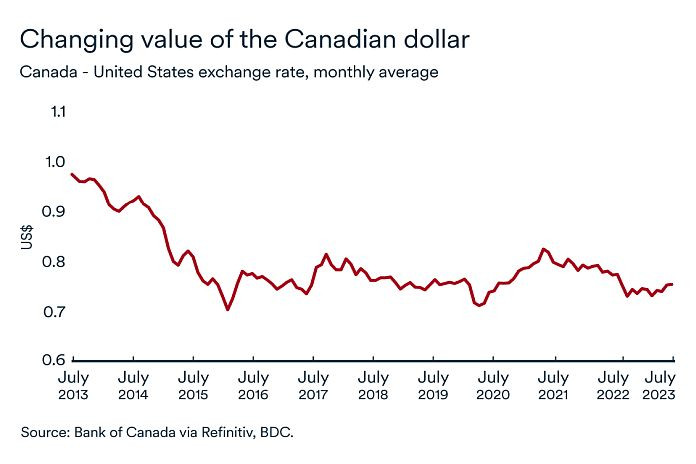By BDC
MONTREAL, Canada – Economic growth in Canada see-sawed during the spring months as a series of interest rate hikes did their intended job of cooling inflation in the country.
Growth was revised upwards to 0.1 percent in March but stagnated in April (0.0%). Half of the sectors covered by Statistics Canada recorded gains in April led by the construction industry, the real estate market and retail. By contrast, slowing hit the wholesale and manufacturing, which experienced its first monthly growth decline of 2023.
StatsCan’s initial estimates for May were positive. According to its preliminary report, GDP rose by 0.4 percent during the month with much of the growth coming from sectors that experienced slowing in April (manufacturing and wholesale). If confirmed, these gains would offset April’s slowdown. But much of the rebound is due to thousands of federal civil servants returning to work, following a strike in April.
Significant improvements in inflation readings
Good news was to be found in the inflation figures. In annual variation, the Consumer Price Index (CPI) rose by 3.4 percent in May. This represents a significant decline from April’s 4.4 percent.
More important than this drop in overall CPI growth was an improvement in core inflation measures (favoured by the Bank of Canada). They were also approaching the Bank of Canada’s target range for inflation of between 1 and 3 percent.
Canada’s central bank is likely to have found even more comfort in another inflation measure – CPI excluding mortgage interest costs. It rose by just 2.5 percent year-over-year.
One dark cloud was food price growth. Here, inflation remained stubbornly high at 8.3 percent. The bank of Canada’s monetary policy has less impact on these prices because foodstuffs are more dependent on global market conditions.
Against this backdrop, we believe the most recent rate increase by the Bank of Canada is likely to be the last if the favourable inflation trend continues.
First rate cut not expected before 2024
The progress on inflation does not mean, however, that the bank will cut rates any time soon. The reaction of Canadian households and businesses to the bank’s rate pause announcement in January demonstrated the extent to which uncertainty and expectations can affect the real economy.
Consumer confidence and business optimism rebounded strongly following the pause announcement, driving consumption, hiring and wages higher. The residential resale market also regained vigour, which along with population growth, supported domestic demand. With inflation heating up again, the Bank of Canada had to step in to cool the enthusiasm with a 25 basis point increase in June.
The strong positive reaction to the pause announcement from businesses and consumers will likely lead the Bank of Canada to be cautious about reigniting inflation pressures when announcing rate reductions. Therefore, we don’t expect easing to begin until the first half of 2024 with the bank’s key rate declining to 3 percent by year end from the current 5.0 percent.
Employment slows but remains strong
Some 60,000 jobs were created in June. This marks a rebound in employment after the losses incurred in May. According to the Bank of Canada’s Business Outlook Survey, the pace of hiring is set to continue to slow in Canada and more job losses are therefore to be expected in the coming months. However, employment losses will remain low since 30 percent of companies are still having difficulty hiring or retaining workers.
There were almost 820,000 job vacancies in the country in April. Population growth should help companies to meet these labour needs, but unemployment could rise again because the process of hiring immigrants is cumbersome, according to companies surveyed by the Bank of Canada. The national unemployment rate rose from 5.2 percent in May to 5.4 percent in June.
The impact on your business
- Despite ongoing economic uncertainty, the Canadian economy remains well-positioned for continued growth. Nevertheless, businesses should expect (and prepare for) a slowdown that will last for several months.
- With inflation falling, the Bank of Canada’s monetary policy is having its desired effect. However, it will be several months before the full impact of past rate hikes is felt in the economy. Rates are unlikely to rise further, but businesses and households will have to be patient in waiting for a rate cut in Canada.
- Wages and the business costs will continue to rise. If your business is struggling with rising costs, it may be time to explore how you can boost efficiency and productivity because it will be less easy to pass on cost increases to consumers in the coming months.
Related: Positive growth data ease recession concerns
“The latest indicators suggest the US Federal Reserve has succeeded in slowing the economy to bring down inflation without tipping the country into recession. Of course, a soft landing for the US economy is still not guaranteed, especially because the Fed is likely to raise interest rates once or twice more between now and the end of the year.”






